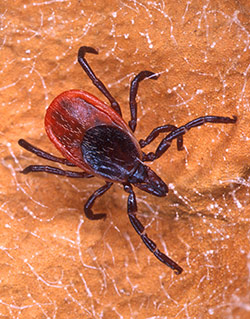Ticks and Mosquitoes: Staying Safe
 |
|
The blacklegged tick (Ixodes scapularis) can carry pathogens that cause diseases such as Lyme and babesiosis. Source: Scott Bauer, USDA Agricultural Research Service, Bugwood.org. |
Here are some facts to help you stay safe from ticks and mosquitoes.
Ticks
Ticks carry pathogens that can cause diseases such as Lyme and babesiosis.
If a tick bites a deer, a mouse, or a person, it can share the bacteria that cause Lyme disease. Once active, the bacteria can cause chills, fever, and even palsy.
There were over 125,000 confirmed cases of Lyme reported in the United States in five recent years. In 2014, 96% of cases were concentrated in fourteen states: in the Northeast, Minnesota, and Wisconsin.
Lyme disease is caused by the bacterium Borrelia burgdorferi and is transmitted to humans through the bite of infected blacklegged ticks (Ixodes scapularis).
In 2015, a project funded by the Northeastern IPM Center began to explore how winter soil conditions affect tick survival rates and population size. The award was approximately $45,000. Kirby Stafford of the Connecticut Agricultural Experiment Station is heading the project.
Notable tickborne diseases include anaplasmosis, babesiosis, ehrlichiosis, Lyme disease, and Rocky Mountain spotted fever.
 |
|
Download the Tip & Trash poster. |
Mosquitoes
The Asian tiger mosquito (Aedes albopictus) preys on humans during the day. It likely transmits the Zika and West Nile viruses. Aedes aegypti is also believed to transmit Zika.
It can reproduce in a bottle cap of water, or in flowerpots, clogged gutters, rain barrels, and wading pools.
In 2011, the Northeastern IPM Center funded a three-year research and extension project headed by Paul Leisnham, an ecologist at the University of Maryland, to manage the mosquito in diverse neighborhoods of Baltimore. Download the Tip & Trash poster and see the project’s tip-of-the-month website.
Resources
“Bites from ticks and mosquitoes are important — and preventable — causes of illness. The risk is considerable. Lyme disease is the most common vector-borne disease in the United States. West Nile virus causes focal outbreaks of febrile and neurologic illness, and several states and territories are experiencing local dengue transmission,” said Emily C. Zielinski-Gutierrez of the Center for Disease Control and Prevention.
Above quotes from “Here Come the Bugs: Protection from Insect and Tick Bites” Emily C. Zielinski-Gutierrez, DrPH, MPH.
http://www.medscape.com/viewarticle/742352
See also the Tick Encounter website.
http://www.tickencounter.org/
